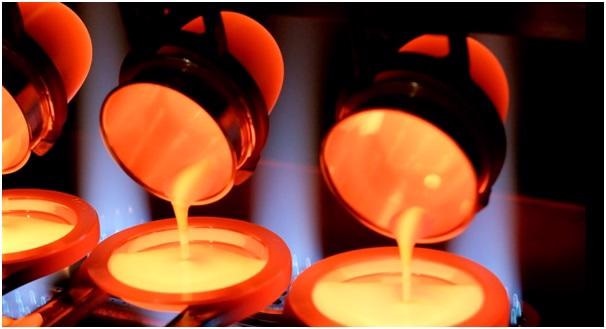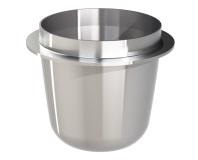
Sample fusion entails dosing a granulated or powdered sample of mineral with a precise ratio of lithium borate and any required additives, before melting the combination in a fusion heater set to a high temperature.
The heating chamber within a fusion fluxer often climbs to temperatures of up to 1250 °C (2282 °F), making it important to utilize accurate labware with high thermodynamic stability and no cross-reactivity with samples.
Platinum crucibles have an incredibly high melting point and a small chance of reacting with chemicals even at extreme temperatures which makes them a good tool when fusing samples at high temperatures. This allows analysts to make samples of a high purity and good homogenous quality for precise x-ray fluorescence (XRF) or inductively-coupled plasma (ICP) analysis.
Challenges for Fusion Platinum Crucibles
As platinum and its alloys have a particularly high thermodynamic stability it has often been used in laboratory environments, however the material’s ductility is just as important when using it for the fusion of samples.
Platinum is particularly malleable and can be created into many crucible profiles of widely varying dimensions, from smaller platinum crucibles with capabilities that are volumetric (as low as 8 ml) to the thicker Capsule-Kawin containers.
The point of the far-reaching range is to allow for the best containment of samples of broad chemical compositions and viscosity. The best platinum crucibles can continue to be mechanically stable throughout fusion processes of a high temperature, even though they can undergo extensive internal strain from phase transitions in each sample as solids melt into an elastic, molten combination.
The profile depth and geometry of a platinum crucible necessitates the amount of sample fixture that can be fixed and transported into a platinum mold, along with the necessary degrees of agitation throughout the process of heating.
Crucibles can be rocked to various levels to allow the mineral sample to fuse homogeneously with the lithium metaborate or lithium tetraborate combination. Lids that have been reinforced can be provided for increased stability through process reactivity, especially useful when volatile compounds are present.
Platinum crucibles are most often made using pure platinum or alloys with various degrees of rhodium or gold. Platinum-gold crucibles with nominal gold contents of 5% and a melting point of between 1780 – 1850 °C are hailed as the industry benchmark of platinum crucibles in the preparation of fusion samples.
Platinum-gold crucibles have an enhanced thermodynamic stability instead of pure platinum. They allow for enhanced sample removal for a better throughput of sample preparation as they can be used at regular temperatures of between 1250 – 1300 °C (2282 – 2372 °F) and are entirely non-wetting to molten glass.
Platinum crucibles to use in processes for the fusion of samples are frequently placed under extensive thermodynamic strain and the corrosive nature of the molten materials can create slow, mechanical wear-and-tear, which can lead to the early failure of components, even though the material has a low reactivity.
This can cause issues for chemical analysts creating fused discs or beads to use in x-ray fluorescence (XRF) analysis, as the reductions in the chemical topography of the platinum crucible’s surface layers can significantly limit the precision of results. This can also mean that labware can develop cracks that allow molten fluids to escape, and can cause extensive damage to fusion machines.
Platinum crucibles often fail because of poor process control procedures as opposed to defective platinum labware. This article details solutions for improving the physical integrity of platinum crucibles over time, and explores the factors that can make the surface life of platinum smaller.
What Conditions Cause Platinum Crucibles to Fail?
As platinum has a low reactivity and avoids oxidation under any temperature, it has been considered the best material for creating labware for delicate sample preparation methods. The low reactivity of the material does not particularly constitute chemical inertness in light of the entire periodic table, but there are particular materials that are highly responsive to platinum at a higher temperature.

Chromium (Cr), nickel (Ni), and zinc (Zn) quickly respond to platinum at temperatures over 1200 °C (2192 °F). Metallic molecules can transport into the physico chemical structure of a platinum crucible which creates damage depending on the degree of contamination, with slight cracks at the lower-part of the platinum crucible’s profile showing a larger degree of contamination.
Smaller degrees of contamination may not create such extreme damage to the structure, but it can create chemical leaching when carrying out further fusion procedures, which can contaminate samples and massively reduce the precision of results.
Fusing samples that have a particularly high lead (Pb) or silver (Ag) content can lead to a large reduction in the melting point of the platinum crucible due to undesired alloying. Even slight levels of cross contamination can mean that holes form in the platinum crucibles, rendering the product useless and providing an extreme risk to fusion machinery.
How to Avoid These Conditions
To reduce the formation of undesired alloys and the cross contamination of metals, there must be strict control of the oxidizing factors in the process of fusion. Oxidant additives can be utilized in fusion flux combinations to make sure that compound oxidation happens before the melting of the flux or within the fusion process.
These steps reduce the chances of leachable molecules attacking the platinum crucible chemically and enhances mechanical stability over longer time periods. It is also necessary to analyze platinum crucibles often to make sure cracks or holes have not formed due to chemical corrosion. These formations can be observed through a microscope to find out the metallic composition of the metallic grain.

This information has been sourced, reviewed and adapted from materials provided by XRF Scientific.
For more information on this source, please visit XRF Scientific.